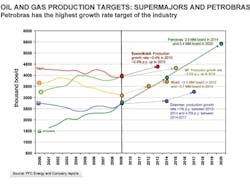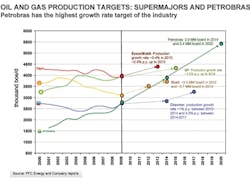Success continues off Brazil while Falklands show increasing promise
Eldon Ball
Senior Editor, Technology & Economics
Exploration successes continue offshore Brazil for Petrobras and other operators – including OGX and Maersk – while Rockhopper and Falkland Oil & Gas are making new progress off the Falkland Islands.
OGX Petróleo e Gás Participações S.A. recently found hydrocarbons in the Albian section of appraisal well 3-OGX-36D-RJS in block BM-C-41 offshore Brazil in the Campos basin.
The oil column is approximately 135 m (443 ft) with a net pay of about 60 m (187 ft), reports OGX. This directional well, drilled to 3,612 m (11,850 ft), is a pilot well for the horizontal well that will be drilled next. BM-C-41 block is 77 km (48 mi) off the coast of the state of Rio de Janeiro at a water depth of approximately 128 m (420 ft). The rigOcean Star initiated drilling there on Feb. 14, 2011.
“As we expected, the results from OGX-36D confirm the connectivity of the accumulations in the carbonate reservoirs in the Albian section previously discovered through the drilling of well 1-OGX-2A, Pipeline,” commented Paulo Mendonça, general executive officer of OGX.
OGX also discovered hydrocarbons in its 1-OGX-31-RJS well in BM–C-41 in shallow waters of the Campos basin. OGX reported oil column of about 149 m (489 ft) with approximately 48 m (157 ft) of net pay in the Albian section and a column of 59 m (194 ft) with net pay of 23 m (75 ft) in the Aptian section. OGX drilled the OGX-31, also known as the Osorno prospect, to a TD of 3,786 m (12,421 ft).
Petrobras in February announced a new oil discovery in the Santos basin. The 4-BRSA-818 (4-RJS-668) well on the Macunaíma structure was drilled in a water depth of 2,134 m (7,001 ft), 244 km (152 mi) off the coast of Rio de Janeiro state, in block BM-S-10. It flowed 26 º API oil. Evaluation will continue, in line with the National Petroleum Agency (ANP)-approved appraisal plan.
Petróleo Brasileiro S.A. also recently reported success from its extension drilling at exploration well 3-BRSA-891A-RJS in the Iara Evaluation Plan offshore Santos basin concession BM-S-11. The pre-salt well is 8 km (5 mi) from the discovery well in 2,279 m (7,477 ft) of water. Formation tests are to be performed to determine productivity.
Petrobras has a new light oil discovery in block BM-S-9 in the Santos basin. Well 3-BRSA-861-SPS (Carioca North-East) was drilled in a water depth of 2 151 m (7,057 ft), around 275 km (171 mi) offshore São Paulo state and 9 km (5.6 mi) northeast of the Carioca discovery well.
Initial analysis has revealed an oil accumulation (around 26° API) in a 200-m (656-ft) reservoir section. Block BM-S-9 comprises two appraisal areas – Guará and Carioca. Petrobras is operator, in partnership with BG Group and Repsol.
Petrobras has ordered 32 subsea trees at a cost of $125 million from FMC. This is the remaining equipment covered in a frame agreement announced in 2010. Deliveries are to begin in 2013.
Earlier, Petróleo Brasileiro S.A. contracted the construction of seven drilling rigs to Estaleiro Atlântico Sul at a total cost of $4.6 billion, or a unit price of $662 million. Petrobras will assign the construction contracts to Sete Brasil S.A which will charter the rigs.
Day rate for each rig is estimated at $430,000-475,000. The first rig is scheduled to start operating in 2015.
A third bidding process to contract the chartering of packages up to four rigs is still under analysis and should be completed soon, Petrobras says.
Maersk results
Maersk Oil Brasil/OGX has proven oil in the Carambola B structure in Brazil’s Campos basin.
The confirmation well is in the BM-C-37 license in 130 m (426 ft) water depth, 80 km (49.7 mi) off the coast of the state of Rio de Janeiro. Maersk is operator, with a 50% interest in the block. Drilling continues towards a planned depth of 3,000 m (9,850 ft) below sea level.
Hydrocarbons were encountered in the target Albian carbonates. The preliminary estimate is of up to 17 m (55.8 ft) potential net pay. Logging has been performed, including coring, pressure measurements and hydrocarbon sampling, and Maersk says further work will be needed to assess productivity.
“Results of the Carambola B well will be integrated with the Carambola A results announced early January 2011,” said Bruce Laws, president of Maersk Oil Houston. “This exercise will help us assess the commercial potential of the oil contained in complex carbonate reservoirs.”
Bureau Veritas recently agreed with COPPE/UFRJ, the Ocean Engineering department of the Universidade Federal do Rio de Janeiro, to form a joint development center for deepwater technology.
Pierre Besse, VP Research and Development for Bureau Veritas in Paris said: “We will initially have four people working full time on the Rio university development group, so we can marry up the modeling strengths and structure experience of Bureau Veritas with the academic and practical expertise in the offshore sector in Brazil.
“We expect to see real useable tools and new software and technical developments to help get the next generation of floaters and deepwater subsea systems onstream quickly and safely. The Ocean Basin at COPPE/UFRJ is equipped with sophisticated multi-directional wave generators and the deepest model basin in the world, and we can use those to develop safe and clean technologies to promote deepwater offshore energy exploitation,” Besse added.
“The projects will be mainly linked to the development of technology for the exploration and production of the recently discovered pre-salt fields in ultra-deep waters in the offshore Santos basin in Brazil.”
According to Segen Farid Stefen, director of Technology and Innovation at COPPE/UFRJ, “The first development project is already under way, tackling some important aspects in the evaluation of dynamic positioning systems for oil shuttle tankers, in connection with off-loading operations offshore.”
Bureau Veritas works with other academic institutes in the Far East, Australia, and Russia. With Harbin Engineering University in China, Besse pointed out, “we have produced a fully coupled analysis of deepwater floating systems, which helps develop TLP/Spars/FLNG projects by delivering the latest in hydrodynamic modeling.”
Meanwhile, US President Barak Obama visited Brazil recently to urge them to drill extensively offshore the country. The US has backed a $2-billion Export-Import Bank loan to Petrobras to develop offshore technology. It was a direct contrast to US domestic offshore policy, where US waters off the East Coast, West Coast, and much of the Gulf of Mexico are under a seven-year drilling moratorium and permits in other areas are difficult to obtain because of increased regulatory requirements.
Falklands
Rockhopper Exploration says it has proven a substantial oil column in its Sea Lion discovery in the North Falkland basin. Its latest appraisal well (14/10-4) encountered 33 m (108 ft) net pay in a good quality reservoir. It also established an oil/water contact at 2,477 m (8,127 ft) TVD subsea in the main fan, which suggests that the southern main Sea Lion fan is full to spill.
This latest well aimed to investigate reservoir presence and the oil column at a downdip location. The results were close to Rockhopper’s geological prediction.
Top Sea Lion reservoir sands were encountered 66 m (216 ft) downdip from the 14/10-2 well, 2.3 km (1.4 mi) to the southeast. The program revealed 107 m (351 ft) of reservoir comprising four main sands, with average porosity of 20% and permeability of over 100 md.
Rockhopper says 30 m (98 ft) of net pay were intersected in the upper of the four sands, representing the main Sea Lion southern fan. The gross oil column now proven in the main Sea Lion southern fan is 104 m (341 ft).
In the lower sands, some 3 m (9.8 ft) of net oil pay were present. These thin sands are below the water leg of the upper sands, suggesting the presence of at least one additional oil column. They also confirm prospectivity for lower fan sequences developed elsewhere downdip.
A mini-drillstem test was conducted using a dual-packer MDT tool over a 1-m (3.3-ft) interval at 2,486 m (8,156 ft) drilled depth within the oil column. This test flowed oil into the wellbore, providing additional samples and pressure build-up data, which suggest that flow rates and producibility here are better than at the discovery well.
A single MDT sample chamber was opened on the rig and initial wellsite analysis indicates medium-grade oil similar to that in 14/10-2.
After plugging and abandoning the well, the semiOcean Guardian will next drill the Ninky prospect in the same basin for Desire Oil, before reverting to Rockhopper to drill a minimum of three further appraisal wells on the Sea Lion feature, and possibly more, along with further exploration wells.
Rockhopper now plans to start development planning for Sea Lion.
Falkland Oil and Gas Ltd (FOGL) says it is at an advanced stage in contract negotiations for a deepwater rig for its Southern License area acreage offshore the Falkland Islands.
BHP Billiton, as operator of the company’s Northern License area, is also in talks to secure a rig slot to drill the Loligo prospect.
Recently, the partners renegotiated the terms of the Northern License area with the Falkland Islands government. The permits have been extended by one year without any further work commitments or mandatory acreage relinquishments.
On the Southern License area, the Phase I work commitment was completed last year following an unsuccessful well on the Toroa structure.
BHP elected not to enter the second phase, which started on Dec. 3, assigning its 51% interest and operatorship to FOGL, which now has full control over these concessions, and may pursue another farm-out agreement.
FOGL has contracted a vessel to perform a site survey to determine locations for future wells. This will cover separate sites including the Vinson prospect, in the Tertiary channel play, and two new prospects (Scotia and Hero) within the mid-Cretaceous fan play.
Site surveys also will be acquired on Inflexible, a Springhill fault-block, and Undine, a Tertiary fold-belt play prospect. Springhill and Undine are similar to targets Borders and Southern intends to drill in the same region. FOGL will have the option to drill in the event that Borders and Southern has success with its wells.
FOGL may also opt to acquire up to 1,300 km (808 mi) of new 2D seismic data to enhance prospect definition and assist selection of drilling locations.
Guyane
Operator Tullow Oil has spudded well GM-ES-1 on the Zaedyus prospect in the Guyane Maritime Permit, says partner Northern Petroleum. The well is offshore of Guyane about 50 km (~30 mi) from the Brazilian border.
TheEnsco 8530 is drilling to a planned 6,500 m (21,325 ft) subsea to test an undrilled Late Cretaceous fan system.
Tullow has stated that the Zaedyus prospect has an estimated P10 prospective resource of 700 MMbbl and is geologically analogous to its Jubilee field off the coast of Ghana, Africa.
Tullow holds 27.5%, Northern has 1.25%, Shell E&P France SAS 45%, Total E&P Guyane Francaise SAS also 25%, and Wessex Exploration at 1.25%.
Guyane, also known as French Guiana, is a non-sovereign overseas department of France, located on the Caribbean coast of South America.


